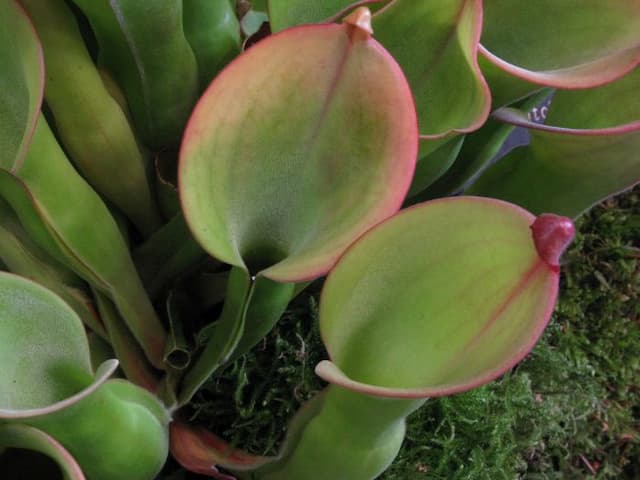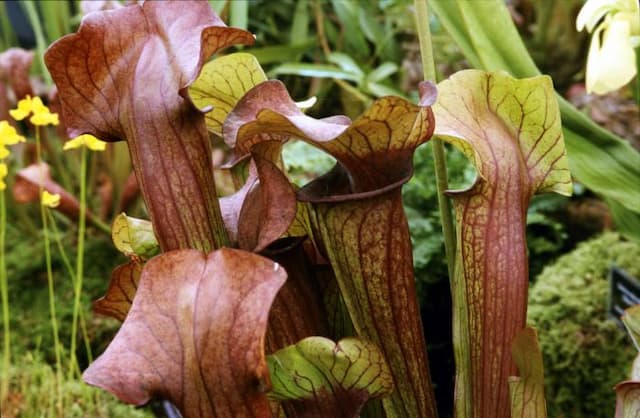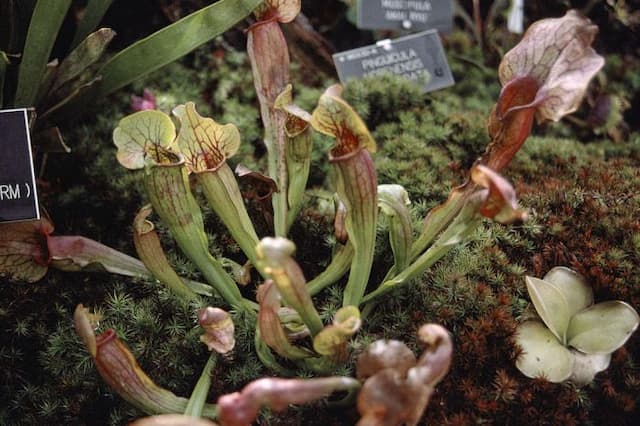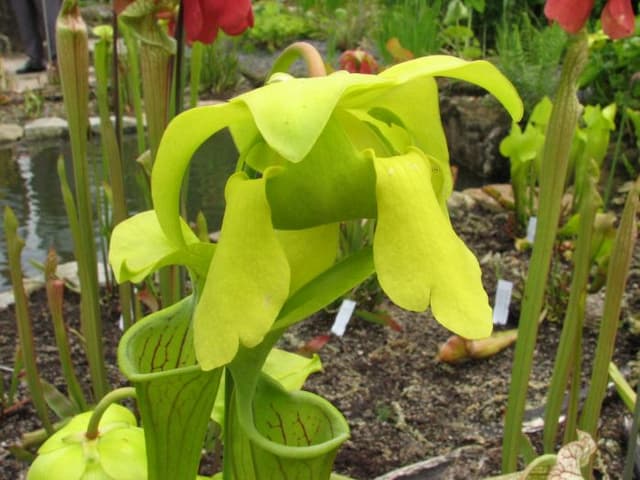Copper Trumpet Pitcher Plant Sarracenia flava var. cuprea

ABOUT
The plant in question, commonly known as the copper pitcher plant, is noted for its unique and striking appearance that easily catches the attention of passersby. This plant is characterized by its pitcher-shaped leaves or tubes, which are designed to trap insects. These leaves are vibrant in color, showcasing shades of yellow and green that can be highlighted with reddish or coppery veins, which is where it gets its common name from. The upper portion of the pitchers, known as the hood, covers the opening and can sometimes bear a slightly different hue, giving a two-toned effect that adds to its visual appeal. During its blooming period, the copper pitcher plant produces flowers that are held aloft on tall stalks, separate from the pitchers. These flowers can be quite large and are typically a yellow hue, contributing to the plant's overall exotic look. The contrast between the pitchers and the flowers adds an additional layer of interest. The interior of the pitchers has a slippery surface with downward pointing hairs that prevent trapped insects from escaping, aiding the plant in its carnivorous lifestyle. The plant exhibits a form that is not only attractive but has evolved for a specific function, making it a fascinating specimen for both enthusiasts and casual observers.
About this plant
 Names
NamesFamily
Sarraceniaceae
Synonyms
Yellow Pitcher Plant, Trumpet Pitcher, Copper Lid Pitcher Plant
Common names
Sarracenia flava var. cuprea
 Toxicity
ToxicityTo humans
The plant in question is commonly known as the Yellow Pitcher Plant. There is no widespread documented toxicity to humans for this carnivorous plant, and it is generally not considered to be poisonous upon touch or ingestion. However, because it is not a food plant and has evolved to attract and digest insects, it is not advisable to ingest any part of it. If ingested, it is possible though unlikely for someone to experience gastrointestinal discomfort or an allergic reaction due to individual sensitivities. If any adverse reactions are noticed following ingestion, it would be wise to seek medical advice.
To pets
The Yellow Pitcher Plant is not commonly listed as a toxic plant to pets. As with humans, this plant is a carnivorous species meant to digest insects, not to serve as food for animals. While it is not known to be toxic, ingestion by pets could potentially lead to gastrointestinal irritation or an allergic reaction in sensitive individuals due to its unusual nature and the enzymes it contains for digesting insects. It is always best to prevent pets from ingesting plants that are not part of their regular diet to avoid potential complications. If your pet does ingest parts of this plant and displays signs of distress, consult a veterinarian.
 Characteristics
CharacteristicsLife cycle
Perennials
Foliage type
Evergreen
Color of leaves
Green
Flower color
Yellow
Height
2-3 feet (60-90 cm)
Spread
1-2 feet (30-60 cm)
Plant type
Herb
Hardiness zones
6
Native area
Southeastern United States
Benefits
 General Benefits
General Benefits- Attracts Pollinators: The Yellow Pitcher Plant produces nectar to lure insects, which can benefit the pollination of nearby plants.
- Ornamental Use: This variety, with its coppery hood and green pitcher, is visually striking and makes for an interesting addition to gardens.
- Pest Control: Sarracenia flava var. cuprea is carnivorous and traps insects, reducing the number of pests in the garden.
- Education and Research: It serves as a model organism for studies in botany and ecology, especially trap mechanisms and plant-insect interactions.
- Conservation Status Indicator: This plant can be used to indicate the health of the ecosystems where it naturally occurs, which are often sensitive habitats.
- Habitat Creation: The plant provides a microhabitat for various organisms, like Sarracenia mosquito (Wyeomyia smithii), which completes its life cycle within the pitchers.
 Medical Properties
Medical Properties Air-purifying Qualities
Air-purifying QualitiesThis plant is not specifically known for air purifying qualities.
 Other Uses
Other Uses- The yellow pitcher plant can be used as a unique educational tool to demonstrate carnivorous plant mechanisms and adaptations to students and enthusiasts.
- This plant's unusual structure makes it an intriguing subject for botanical artists and photographers.
- Due to its specialized habitat, Sarracenia flava var. cuprea can be used in ecological studies to understand bog ecosystems and their conservation needs.
- Insect control is a practical application since it can naturally reduce the number of small flying insects by trapping them.
- A unique garden feature, it adds dramatic visual interest to water gardens and bog garden settings.
- Some hobbyists collect and breed this plant, creating hybrids that offer a variety of colors and shapes not found in wild populations.
- It has potential use in monitoring environmental changes, as its growth and health can indicate the quality of its environment.
- The yellow pitcher plant may be a source of inspiration for designers and engineers when designing materials and surfaces that require a one-way mechanism (inspired by its one-way trap).
- Its pitchers can be used in small-scale composting of insects, breaking down the trapped organic matter into nutrients for the plant.
- The flower’s durability and unique look make it a candidate for dried flower arrangements and botanical displays.
Interesting Facts
 Feng Shui
Feng ShuiThe Yellow Pitcher Plant is not used in Feng Shui practice.
 Zodiac Sign Compitability
Zodiac Sign CompitabilityThe Yellow Pitcher Plant is not used in astrology practice.
 Plant Symbolism
Plant Symbolism- Adaptation: The Sarracenia flava var. cuprea, commonly known as the Copper Pitcher Plant, is a species adept at thriving in nutrient-poor environments by adapting its leaves into pitfall traps to capture insects. Therefore, it symbolizes the ability to adapt and make the most out of challenging situations.
- Uniqueness: This variety is noted for its distinctive copper-colored top, setting it apart from other pitcher plants. It represents uniqueness or standing out from the crowd.
- Patience: As a carnivorous plant, the Copper Pitcher Plant patiently waits for its prey to fall into its trap, symbolizing patience and the idea that good things come to those who wait.
- Attraction and Deception: The plant lures insects with its color and nectar, serving as a metaphor for attraction that may lead to a deceptive end, indicating that not everything attractive is necessarily good.
 Water
WaterThe Trumpet Pitcher plant should be watered generously to keep the soil consistently moist but not waterlogged, resembling its native boggy habitat. It's essential to use distilled water, rainwater, or reverse osmosis water as tap water can contain minerals harmful to the plant. During the growing season in spring and summer, the soil should not dry out, so water maybe once or twice a week, ensuring about a quarter gallon per week for a medium-sized pot. In the dormancy period of fall and winter, reduce watering to when the soil starts to dry on the surface.
 Light
LightThe Trumpet Pitcher plant thrives in full sun to partial shade, and it requires at least six to eight hours of direct sunlight daily for optimal growth. The best spot for it is outdoors in a sunny position or in a bright, sunny window with some protection from the hottest midday sun which could otherwise scorch its leaves.
 Temperature
TemperatureThe ideal temperature range for the Trumpet Pitcher plant is between 70°F to 85°F during the day, with a night temperature drop to between 50°F and 65°F. These plants can survive temperatures as low as 20°F in the winter, but should not be exposed to prolonged periods of freezing temperatures. They appreciate warmer temperatures during their active growing season in the spring and summer.
 Pruning
PruningPruning the Trumpet Pitcher plant usually involves removing dead or damaged pitchers and leaves to encourage new growth and maintain plant health. It's best to prune in early spring, before the new growth begins. You should only need to prune once a year, unless there is visible damage or disease at other times.
 Cleaning
CleaningAs needed
 Soil
SoilThe Yellow Pitcher Plant prefers a soil mix of sphagnum peat moss and perlite or sand in a ratio of about 1:1. The ideal soil pH should be acidic, within the range of 4.5 to 5.5.
 Repotting
RepottingYellow Pitcher Plants should generally be repotted every 2 to 3 years to prevent compaction of their soil and ensure healthy growth.
 Humidity & Misting
Humidity & MistingYellow Pitcher Plants thrive in high humidity conditions, preferably above 50% to mimic their natural bog habitat.
 Suitable locations
Suitable locationsIndoor
Provide bright light, keep soil moist, and ensure high humidity.
Outdoor
Full sun to partial shade, maintain moist soil, protect in winter.
Hardiness zone
6-8 USDA
 Life cycle
Life cycleThe Copper Pitcher Plant (Sarracenia flava var. cuprea) begins its life cycle as a seed, typically reliant on a moist, acidic substrate to germinate, often in spring. Seedlings emerge with small, non-carnivorous leaves initially, slowly developing the characteristic pitcher-shaped leaves as they mature and can photosynthesize and engage in carnivory for additional nutrients. Once the plant reaches maturity, it produces tall, yellow flowers in the spring, typically before the new pitchers fully develop, to avoid trapping potential pollinators. After pollination, seeds are produced and dispersed, usually by wind or water. The plant's pitchers, which last for one growing season, die back in the winter, while the rhizome (the underground part of the stem) survives to sprout new growth the following spring. This perennial cycle continues year after year, with individual plants living for many years.
 Propogation
PropogationPropogation time
Spring-Early Summer
The most popular method of propagating the Trumpet Pitcher Plant (Sarracenia flava var. cuprea) is by division, which is ideally performed in late winter or early spring before new growth begins. This involves carefully taking the plant out of its pot and gently dividing the rhizome, the plant's underground stem, making sure that each division has at least one growth point. These sections can then be potted individually in a mix of peat and perlite, kept moist, and placed in a warm, brightly lit area but out of direct sunlight. Such division not only helps to propagate new plants but also rejuvenates older plants that might have become too large or congested. Divisions should be watered regularly and allowed to establish for several weeks before being subjected to the full growing conditions typical for the species.









